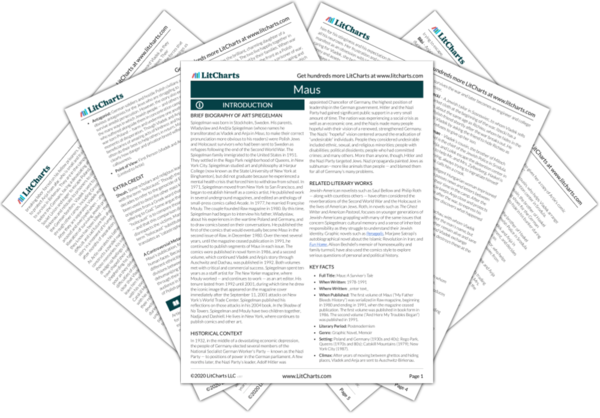Welcome to the LitCharts study guide on Art Spiegelman's Maus. Created by the original team behind SparkNotes, LitCharts are the world's best literature guides.
Maus: Introduction
Maus: Plot Summary
Maus: Detailed Summary & Analysis
Maus: Themes
Maus: Quotes
Maus: Characters
Maus: Symbols
Maus: Theme Wheel
Brief Biography of Art Spiegelman

Historical Context of Maus
Other Books Related to Maus
- Full Title: Maus: A Survivor’s Tale
- When Written: 1978-1991
- When Published: The first volume of Maus (“My Father Bleeds History”) was serialized in Raw magazine, beginning in 1980 and ending in 1991, when the magazine ceased publication. The first volume was published in book form in 1986. The second volume (“And Here My Troubles Began”) was published in 1991.
- Literary Period: Postmodernism
- Genre: Graphic Novel, Memoir
- Setting: Poland and Germany (1930s and 40s); Rego Park, Queens (1970s and 80s); Catskill Mountains (1979); New York City (1987).
- Climax: After years of moving between ghettos and hiding places, Vladek and Anja are sent to Auschwitz-Birkenau.
- Antagonist: German soldiers and hostile Polish civilians are obvious antagonists for the Jews who are struggling to survive amidst persecution. However, the story also explores the many ways in which Jewish people — and others were who suffered alongside them in concentration camps and in war-torn Poland — harm and undermine one another in moments of desperation. Though Vladek and Anja are beneficiaries of amazing acts of kindness and humanity, and often do their best to help others in return, Maus shows clearly how danger and privation breed selfishness and callousness.
- Point of View: First Person (Vladek and Artie); Third Person (Limited to Artie)
Extra Credit for Maus
Shoah. Some scholars and religious leaders have taken issue with the term “holocaust.” Though the word has been used for decades to refer to the genocide of European Jews, and has been used to describe other mass killings in history, it originates from a Greek word that means “a completely burnt offering to God.” Some argue that to refer to the genocide as a “holocaust” is to compare those murders to religious sacrifices — and that this comparison dignifies the violence and disrespects the victims. Many who disagree with the use of the term “holocaust” substitute “shoah,” a Hebrew term that translates as “catastrophe.”
A Controversial Metaphor. Spiegelman faced criticism, after Maus’s publication, for his use of animal heads in place of human faces. Because different animals correspond to different ethnicities, he was accused of perpetuating Nazi-like divisions between people of different races, and further dehumanizing the same people Nazis had tried to dehumanize through their violence. The book found a particularly harsh audience in Poland, where many were insulted by the depiction of Polish people as pigs.







